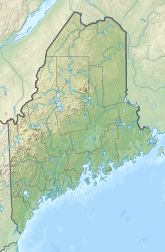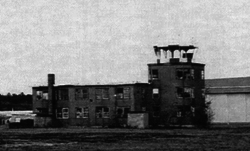| This article uses bare URLs, which are uninformative and vulnerable to link rot. Please consider converting them to full citations to ensure the article remains verifiable and maintains a consistent citation style. Several templates and tools are available to assist in formatting, such as reFill (documentation) and Citation bot (documentation). (August 2022) (Learn how and when to remove this message) |
Airport in Sanford, Maine
| Sanford Seacoast Regional Airport | |||||||||||||||
|---|---|---|---|---|---|---|---|---|---|---|---|---|---|---|---|
| Summary | |||||||||||||||
| Airport type | Public | ||||||||||||||
| Owner | City of Sanford | ||||||||||||||
| Location | Sanford, Maine | ||||||||||||||
| Elevation AMSL | 244 ft / 74 m | ||||||||||||||
| Coordinates | 43°23′38″N 070°42′29″W / 43.39389°N 70.70806°W / 43.39389; -70.70806 | ||||||||||||||
| Map | |||||||||||||||
  | |||||||||||||||
| Runways | |||||||||||||||
| |||||||||||||||
| Statistics (2019) | |||||||||||||||
| |||||||||||||||
| Source: Federal Aviation Administration | |||||||||||||||
Sanford Seacoast Regional Airport (IATA: SFM, ICAO: KSFM, FAA LID: SFM) is a public airport located four miles (6 km) southeast of the central business district of Sanford, a city in York County, Maine, United States. The airport operated as Naval Auxiliary Air Facility Sanford (NAAF Sanford, not to be confused with Naval Air Station Sanford, Florida) supporting operations of Naval Air Station Brunswick from 15 April 1943 until 1 February 1946. This airport is now publicly owned by the City of Sanford.
Facilities and aircraft
Sanford Regional Airport covers an area of 1,115 acres (451 ha) which contains two runways:
- Runway 7/25: 6,389 x 150 ft (1,947 x 46 m), surface: asphalt
- Runway 14/32: 4,999 x 100 ft (1,524 x 30 m), surface: asphalt
For the 12-month period ending 31 December 2019, the airport had 36,738 aircraft operations, an average of 101 per day: 95% general aviation, 4% air taxi, and <1% military. There was at that time 131 aircraft based at this airport: 105 single engine, 9 multi-engine, 2 jet, 11 helicopter, 3 glider and 1 ultra-light.
Fixed-base operator and flight schools
There are a fixed-base operator (FBO) and several flight schools on the airfield.
The FBO is Southern Maine Aviation, which has jet fuel, aviation gasoline (100LL) and MoGas (usually available). They also operate an aircraft maintenance facility and a flight school, and have facilities for transient flight crew and passengers.
There are three flight schools on the field:
- Southern Maine Aviation provides instruction in single engine airplanes, an American Champion Citabria, several Cessna 172-SPs, a complex Cessna 182 and a RedBird Simulator.
- York County Helicopters provides instruction in Robinson R22s and R44s.
- Sanford Soaring provides instruction in gliders to club members.
History
United States historic place| Sanford Naval Air Station Administration Building--Control Tower, Former | |
| Formerly listed on the U.S. National Register of Historic Places | |
 The NAAS tower, c. 1995 The NAAS tower, c. 1995 | |
| Area | less than one acre |
|---|---|
| Built | 1942 (1942) |
| Built by | United States Navy |
| Architectural style | WWII naval control towers |
| NRHP reference No. | 97000603 |
| Significant dates | |
| Added to NRHP | 20 June 1997 |
| Removed from NRHP | 21 March 2023 |
The Sanford Airport began as an airfield constructed by the Sanford Mills in the 1930s, with a single airstrip and hangar. With the entry of the United States into World War II in 1941, the airfield was expanded by the United States Navy in 1942 and formally commissioned as Naval Auxiliary Air Facility Sanford in 1943. It served as one of several secondary airfields to the primary Naval Air Station Brunswick. Its runway network was enlarged and paved, and barracks and a control tower were built on what is now the southwestern side of the airfield. A torpedo squadron and a fighter squadron were stationed here in 1944, and the field was used for training exercises. After the war ended, the facilities were largely mothballed, but remained staffed until the 1960s. Of the structures built by the Navy, only a hangar and the control tower/administration building survived. The latter, once listed on the National Register of Historic Places, was demolished in 2006–2007 because it was in poor condition and the tower was deemed a hazard to aviation.
In 1955, Colonial Aircraft began production of the Skimmer amphibian in Sanford, Maine. Later in 1959, the type certificate for the Skimmer was sold to the Lake Aircraft Corporation. Lake continued to produce modified versions of the Skimmer in Sanford as the Lake Buckaneer and Lake Renegade until 1994. Six record-breaking flights departing from Sanford Airport took place in Lake Renegades, piloted by Robert Mann and Peter Foster in 1988 and 1989. The flights set new altitude records for piston amphibians and seaplanes, flying to a maximum altitude of 27,300 feet.
See also
References
- ^ FAA Airport Form 5010 for SFM PDF, retrieved 7 September 2023
- "Patrol Squadron Shore Establishments" (PDF). United States Navy. Retrieved 7 March 2012.
- ^ http://flyingsma.com
- "Rates". Archived from the original on 3 March 2016. Retrieved 17 October 2014.
- http://sanfordsoaring.com
- ^ "National Register Information System". National Register of Historic Places. National Park Service. 9 July 2010.
- "NRHP nomination for Sanford Naval Air Station Administration Building-Control Tower, Former". National Park Service. Retrieved 12 September 2015.
- "2006-7 Sanford Town Report". Town of Sanford. Retrieved 2 October 2014.
- "Lake History | Lake Amphibian Club". Retrieved 5 April 2020.
External links
- Sanford Regional Airport (City of Sanford web site)
- Resources for this airport:
- FAA airport information for SFM
- AirNav airport information for KSFM
- ASN accident history for SFM
- FlightAware airport information and live flight tracker
- NOAA/NWS weather observations: current, past three days
- SkyVector aeronautical chart, Terminal Procedures